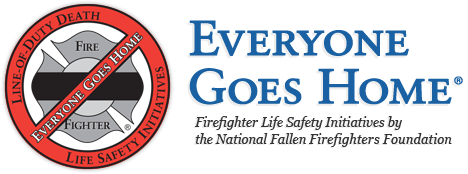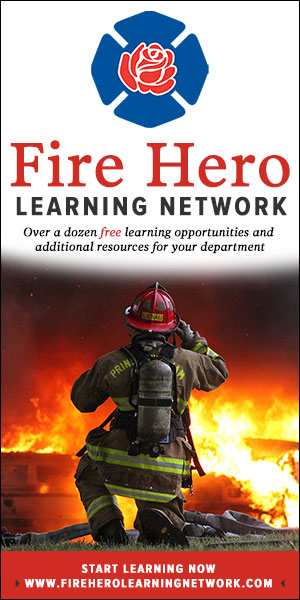By Rick Graba,
Everyone Goes Home® North Dakota Advocate
In 2004, the first National Firefighter Life Safety Summit was held in Tampa, Florida. What resulted from that summit were the 16 Firefighter Life Safety Initiatives and the Everyone Goes Home® program. When many of us first became aware of the Everyone Goes Home® Program we thought to ourselves, “Bonus!” A lot of us already had a passion concerning firefighter safety and wellbeing. We had been out there for years challenging unnecessary firefighter injuries and deaths, while at the same time advocating change. We championed the cause in our own departments, and took advantage of every opportunity to address firefighter safety issues, when and wherever we could. The Everyone Goes Home® program gave us another opportunity to further pursue our passion. Those in attendance at the safety summit issued a challenge to the entire fire service. That challenge was to significantly reduce needless firefighter injuries and line-of-duty deaths. We embraced the challenge!
I’d be willing to bet that many of us were not surprised when Initiative #1 identified “culture” as the leading issue behind firefighter injuries and line-of-duty deaths. For those of us who had already made firefighter safety our passion, it caused us to reflect on why a culture of safety was so engrained and had affected us in such a positive manner. Looking back, there was a person or a defining moment that influenced us early in life, and set us on the right path regarding safety. Along the way there were other moments and people who added to what we already knew to be true and further fueled our passion about safety.
My first memory of consciously thinking about safety was when I was very young. I grew up on a farm and remember being told and shown how to do things safely. If one of us got needlessly hurt, it affected the operation and the whole family. A culture of safety was further reinforced early in my adult life when I started working construction. If I did not work safely and was consequently injured, then I would be unable to work. If I did not work, I did not get paid and my family then suffered. I had a desire to serve, and when the construction industry did not fulfill that desire, I moved on to a career in the fire service. My first “defining moment” came while filling out my personal and family medical history on the entry level questionnaire. My mother had died at age 54 from heart failure, (Check that box.) Imagine my surprise when I discovered that I was able to check all of the boxes, (NOT GOOD!) This immediately set me on a course of trying to take better care of myself.
While still a probie, I experienced what I believe to be my second “defining moment.” I responded to an all-hands fire located in a four-story unoccupied, ordinary construction building at the state penitentiary. I was one of ten firefighters inside a stair tower waiting to attack the fire, when all of the floors collapsed and we were trapped. No incident command system, no accountability, no RIT, no radios, no water in the single 1 1/2″ hose line, with low air alarms going off and no way out. As luck would have it, cooler heads prevailed, and we escaped with the help of a very courageous prison guard. The very next day, I vowed to do whatever it took to get promoted, and I made it my personal mission to get firefighters home safely to their families!
During early 2008, the first Everyone Goes Home® Safety Summit was held in Emmitsburg, Maryland. Attendees agreed the Everyone Goes Home® program is outstanding, but there were some areas of concern that needed to be addressed. One such area involved how to get the program out to the fire departments and firefighters in our respective states. In North Dakota, we had 35 dedicated and trained firefighters ready to passionately deliver the program. The North Dakota Firefighters Association (NDFA), along with the state advocates, would be the points of contact for program facilitators, fire departments, and firefighters who requested the program. But, there was a problem. NDFA’s budget was very small and there were limited funds to help deliver the program across the state. Because of money issues, the initial delivery of the Everyone Goes Home® program was only delivered locally by facilitators in their individual departments and at a few select NDFA sponsored events. During the 2007 North Dakota legislative session there were a number of fire service related bills. At every hearing, we took the opportunity to mention the Everyone Goes Home®program and its benefits to the fire service. Then it happened! Much to our surprise the people at Workforce Safety and Insurance (WSI) had been watching and listening and they wanted to help. A meeting was then arranged to discuss what could be done. The results of that meeting led from what had once been an adversarial relationship, to the forming of a new partnership. (Some would say a culture change.) WSI provided grants that allowed for the delivery of the Everyone Goes Home® program free to every fire department and firefighter across the state of North Dakota. In 2008, every major North Dakota fire service agency and group endorsed the program. At the beginning of 2009, NDFA has made the Everyone Goes Home® program a requirement for Firefighter I certification. Local IAFF affiliates are currently planning to include a short overview of the Everyone Goes Home® program in their Fire Ops 101 programs. Fire Ops 101 is an opportunity for local decision makers and media to learn firsthand about the issues firefighters face and to actually train and live the life of a firefighter for a day. Today, I am proud to say the Everyone Goes Home® program is making a difference in North Dakota.
A second topic of discussion at the summit focused on what appeared to be an alarming rate of firefighter line-of-duty deaths in early 2008. There were those that questioned if the Everyone Goes Home® program was being effective. Program leaders, along with many of the advocates who had been actively presenting the program assured everyone that, yes, there was cause for concern but those early numbers did not tell the whole story. Many advocates emphatically stated that the program was working, and there were many success stories that proved it. For many fire departments and firefighters that had the opportunity to participate in the Everyone Goes Home® program, there was a defining moment during the presentation where they “got it” and it has changed their lives forever.
It has been my experience that success stories are shared by fire departments and firefighters in different ways. I would like to share a couple of North Dakota’s success stories with you. In April of 2008, there was a large wildland fire around Minot, North Dakota. The fire lasted for several days and involved many mutual aid departments. One evening I was sitting at home, watching the local news when the news anchor indicated there would be a report concerning the wildland fires in Minot. The interview was with the assistant chief of the lead fire department. He explained, “We focus on the end result. That’s getting it contained, getting it stopped, and then going home safe. Make sure that everyone you’re working with goes home safe, too!” Later in the interview the assistant chief continued by saying, “The strain was more on my family. They really didn’t know anything except for what they had heard on the news. When we could, we would give updates to the family members telling them that – hey your guys are all right and here’s what they are doing. It takes a toll out on a person and their family, it really does.”
A second more subtle success story that I would like to share, took place in a very small rural North Dakota volunteer department. During the presentation, there was one young overweight firefighter who quietly sat in the last row, keeping his comments to himself throughout the entire program. After I had packed up and was just getting ready to leave, there was a tap on my window. The young firefighter was standing there so I got out of the truck to see what he wanted. The young firefighter looked me straight in the eye and firmly shook my hand saying only “Thank you, I get it,” and then walking away. The story does not end there though, a little over a year later during the state fire school someone called my name, and I turned around. I did not immediately recognize the young man who had hailed me. When the young man realized I did not know him, he quickly introduced himself, and refreshed my memory about our first meeting. He proudly exclaimed that because of his love for the job he had lost 37 pounds by eating right and exercising. His wife gave me a big hug and said “Thank you! You saved his life!” I told them both that I did nothing of the sort. I simply felt compelled to include in my presentation a short story about a coin my grandmother had given me when I graduated from high school. The coin was engraved with an inscription that read, “God, grant me the serenity to accept the things I cannot change, the courage to change the things I can, and the wisdom to know the difference.” I told them both that the inscription on the coin applies to everyone. Life is about choices and this young firefighter made the right choice. Not only for himself but for his community, his department and for his family, (There’s that family word, again!) In a January 2009 article written by Advocate Program Manager Billy Hayes, for the Everyone Goes Home® newsletter, he asks; “So, how are we doing as we approach the halfway mark? Are the numbers the only indicator of success?” I’m pretty sure we all know they are not, and just like the two success stories I’ve shared with you, there are many, many more success stories that prove the Everyone Goes Home® program is working! There are many more fire departments and firefighters in this country that unknowingly, will have their “defining moment” while participating in the Everyone Goes Home® program. It is the moment when they make their choice to have the Courage to Be Safe® so Everyone Goes Home®!
There is an old Chinese proverb that states, “When planting for a year, plant corn. When planting for a decade, plant trees. When planting for life, train and educate people.” Now is the time! Bunker-up, we have commitments and promises to keep!


